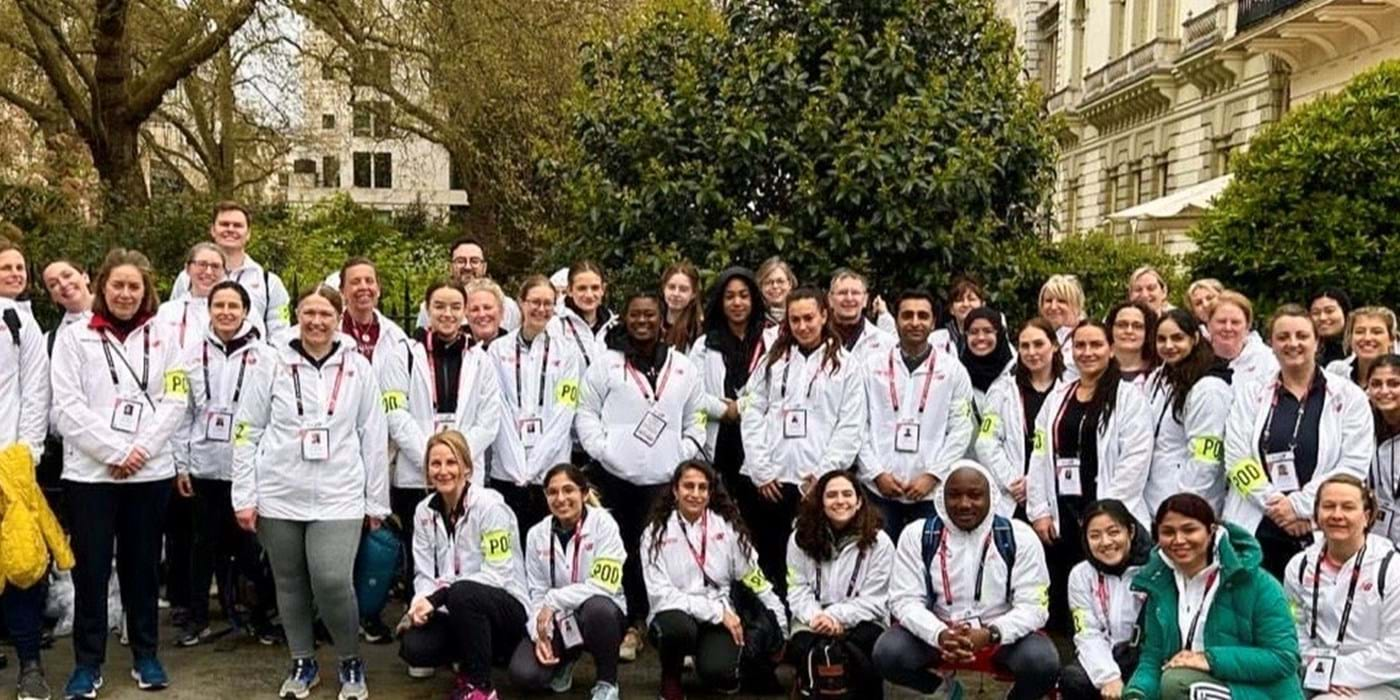AECC UC Podiatrist at London Marathon

For the last 15 years, Associate Professor in Podiatry at AECC University College, Dr Simon Otter, has been volunteering at the TCS London Marathon. He attended this year’s event with over 65 Podiatrists and Podiatry students from across the UK, supporting injured runners.
Simon tells us more about his experience and the role that podiatrists play within a multi-disciplinary team at the event:
“The TCS London Marathon is an amazing day to be part of; there is a real carnival atmosphere. It’s a privilege to volunteer; you see everything that the television cameras see but up close. Many people run for causes close to their heart and it’s very rewarding to witness their achievement.
“Supporting the TCS London Marathon is a great example of a multi-disciplinary team in action. It’s a very collaborative approach to treating patients: the different professionals support each other to help whoever is busiest. We are all volunteers who mostly don’t know each other and we turn up on the day ready to work as a team.”
Schedule on the Day
“We all meet on Marathon Day at 9am for the general briefing, uniform and security badge collection, and medical station allocation. There are five medical stations beyond the finish line and these provide everything from acute medical care to straightforward minor injury management.
“On reporting to your station, there are introductions to the team and to how that station works, the type of patients expected, and the process from when a runner first arrives. This includes required paperwork, how to access runners’ kit bags (there are 46,000+ kit bags managed by an amazing baggage team), as well as the discharge procedure.
“There is then a short lull before elite wheelchair athletes and runners cross the finish; often we go to the finish line and cheer people home. We also need an early lunch ready for being busy! The elite group is followed by high quality running club members often posting times around 2hr 30mins.
“There are medical teams stationed around the course to enable them to finish their race. At the finish line, injured runners identify themselves to the medical team – or alert them to runners who are struggling and need medical assistance.
“It’s a big undertaking and all teams are very busy. The clinical shift runs from 11.30pm to 5pm and some 46,000 athletes cross the finish line during the day.”
Marathon Injuries
“Injuries are weather dependent. If it’s warm and dry, dehydration is an issue and the Physiotherapy teams are very busy managing cramps. If it’s wet, the Podiatry teams can be very busy with wounds and severe blisters. This year was both, so everyone was busy!
“As a team, Podiatrists provide care for a range of lower limb conditions, including foot and ankle pain, acute injuries such as ankle sprains (which are common on cobbled streets), muscle cramps, blisters, and general wound care.
“On receiving a runner, the attending clinician needs to undertake a rapid assessment of their general condition, key background health complaints, and nature of their injury. Some will have multiple problems and getting help from the team can be key.
“Blisters are a big issue with runners when it’s wet and can be very large and severe. We tend to leave them in tact if we can, as the patient’s skin is the best protection and it reduces the risk of infection. We’re looking to clean, dress and protect blisters and wounds. If the blister has split, or is very painful, we would cleanse, debride is needed, apply a sterile dressing and protective padding. We also give runners advice on caring for and managing the blister afterwards.
“It’s important to consider constitutional health and ensure runners are hydrating, replacing electrolytes and carbohydrates, and are not too hot or cold. General health rapidly worsens if runners remain dehydrated and lose body temperature once their marathon is over.
“Treatments aim to enable runners to get home, ensure their complaint does not worsen and offer some general advice going forward.”
Student Support
“I often oversee student podiatrists at the TCS London Marathon. It’s great to see the students grow in confidence as the day goes on; they do more observation at the start of the day and by the end of the day, they are working in pairs to assess and treat patients.
“It’s a fantastic opportunity for students to learn from professionals outside of their discipline too. For example, the physiotherapy team is happy to talk Podiatry students through the treatment that they are doing.
“We seek to enable our students to enjoy their day, gain new clinical experiences, work with other clinicians, and importantly enjoy the general atmosphere.
“Next year, I’m hoping to be joined by Podiatry students from AECC University College.”
You can read Simon’s recent research on the enjoyment and educational value of students volunteering here.


Above: images from the TCS London Marathon